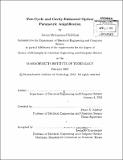| dc.contributor.advisor | Franz X. Kärtner. | en_US |
| dc.contributor.author | Siddiqui, Aleem, 1977- | en_US |
| dc.contributor.other | Massachusetts Institute of Technology. Department of Electrical Engineering and Computer Science. | en_US |
| dc.date.accessioned | 2013-07-10T14:49:18Z | |
| dc.date.available | 2013-07-10T14:49:18Z | |
| dc.date.copyright | 2013 | en_US |
| dc.date.issued | 2013 | en_US |
| dc.identifier.uri | http://hdl.handle.net/1721.1/79494 | |
| dc.description | Thesis (Ph. D.)--Massachusetts Institute of Technology, Dept. of Electrical Engineering and Computer Science, 2013. | en_US |
| dc.description | Cataloged from PDF version of thesis. | en_US |
| dc.description | Includes bibliographical references (p. 179-185). | en_US |
| dc.description.abstract | Optical parametric amplifiers have emerged as important optical sources by extending the properties of few-cycle laser sources, which exist only in materials with sufficiently large gain bandwidths, to wide array of spectral ranges. The work reported in this thesis relates to two areas for the continued development of optical parametric amplification based sources. First, we present a white light seeded, carrier-envelope stable, degenerately pumped OPA producing near tranform-limited sub 7 fs , 3 [mu]J pulses at the driver wavelength from a long pulse, non-CEP stable Ti:sapphire regenerative amplifier. Problems to the spectral phase jump at the driver wavelength, 800 nm, were avoided by using a near infrared OPA to produce white light continuum down to 800 nm where the spectral phase is smooth. Secondly, enhancement cavities are used in conjunction with parametric amplifiers resulting in a new technique entitled, cavity-enhanced optical parametric chirped-pulse amplification (C-OPCPA). C-OPCPA increases the capabilities of nonlinear crystals and can allow continued scaling of parametric amplifier systems to high repetition rate. This work contains the first theoretical and experimental investigation of C-OPCPA. Numerically, passive pump pulse shaping of the intracavity pump power is shown to enable octave spanning gain. Experimentally, a first proof-of-principle experiment demonstrates a 78 MHz C-OPCPA with more than 50% conversion with under 1 W of incident pump power. A comparison to a single pass system shows improvements in the C-OPCPA of orders of magnitude in conversion efficiency and 3 fold increase in phase matching bandwidth in 10 and 20 mm periodically poled lithium niobate phase matched for parametric amplification with 1030 nm pump wavelength and a 1550 nm signal wavelength. A Yb-fiber laser based CPA system producing up to 5 W of 500 fs pulses comprises the pump source, and a Er-fiber laser the signal. | en_US |
| dc.description.statementofresponsibility | by Aleem Mohammad Siddiqui. | en_US |
| dc.format.extent | 185 p. | en_US |
| dc.language.iso | eng | en_US |
| dc.publisher | Massachusetts Institute of Technology | en_US |
| dc.rights | M.I.T. theses are protected by
copyright. They may be viewed from this source for any purpose, but
reproduction or distribution in any format is prohibited without written
permission. See provided URL for inquiries about permission. | en_US |
| dc.rights.uri | http://dspace.mit.edu/handle/1721.1/7582 | en_US |
| dc.subject | Electrical Engineering and Computer Science. | en_US |
| dc.title | Few-cycle and cavity-enhanced optical parametric amplification | en_US |
| dc.type | Thesis | en_US |
| dc.description.degree | Ph.D. | en_US |
| dc.contributor.department | Massachusetts Institute of Technology. Department of Electrical Engineering and Computer Science | |
| dc.identifier.oclc | 849647720 | en_US |
